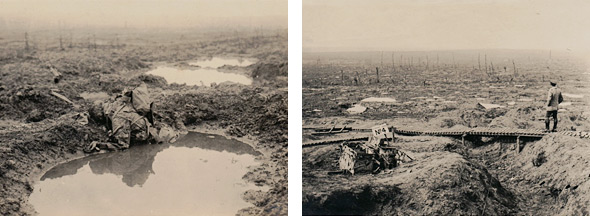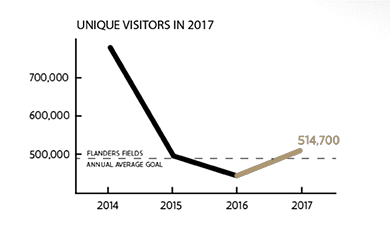1. MARKET SITUATION
' Flanders Fields 14-18 ' is a destination program established by the Flemish tourism authority Visit Flanders. Commemorating the First World War, it was designed to attract visitors from European and selected overseas markets to WWI battlefields, cemeteries, memorials and museums in the Belgian region of West Flanders.
In 2014, the centenary of the outbreak of the war, ' Flanders Fields 14-18 ' helped to drive a record-high number of unique visitors to the area of 789.500. This was an increase of more than 90% compared to 20131.
However, the next two years were expected to decline due to the historical context, as such we saw declines in unique visitor numbers year-on-year: -37% in 2015, -21% in 20162.
Visitor decline meant the turnover generated in the local economy fell by 14% from € 52.300.000 in 2015 to € 45.000.000 in 20163. As well as the revenue from the top 11 Flanders Fields venues, which fell 30% from € 5.501.870 in 2015 to € 4.200.014 in 20164.
For the year 2017, the challenge was to grow again and try to reach the average target goal of 500.000 unique visitors per year set at the start of the programme.
The fear of terror that overshadowed Belgium after the Brussels lockdown in 2015 and the bombing attacks in 2016 caused many Europeans to switch their holidays towards 'safe' destinations like Spain or Portugal (+3%)5, whereas visits to Belgium were forecast to decline by 11%.
In 2016, Europe suffered an overall loss in tourism demand, most notably from long-haul Asian markets6.
Partly as a consequence of the fear of terror, 'Staycations' had made a big comeback, as many travelers holidayed locally rather than further afield. Global Google searches for 'staycations' rose in 2015 and 20167.
There was also an element of WWI fatigue to be overcome after 3 years of highly publicised centennial events.
- Research Remembrance Tourism 2017
- Research Remembrance Tourism 2017
- Research Remembrance Tourism 2017
- Agency research, 2017
- ITB world travel trends report 2016/2017
- European Travel Commission Report, 2017
- Google trends, May 2018
|
 |
|
 |
2. OBJECTIVES
For the year 2017, the agency set out clear KPI's to evaluate the campaign8:
- Unique Visitors
Reach Flanders Fields' 500.000 (+11,7%) annual average goal of unique visitors in 20179.
- Turnover
Increase the turnover generated in the local economy to € 50.000.000 in 2017 (+11%)10.
Secondary revenue objective
Increase revenue for the top 11 Flanders Fields venues from targeted markets (UK, Ireland, France, Germany, Netherlands, Canada, USA, Australia and New Zealand with a goal of € 4,452,015 (+6%) in revenue11.
- Tourism arrivals & overnights
Grow arrivals from targeted markets (UK, Ireland, France, Germany, Netherlands, Canada, USA, Australia and New Zealand by 5% and overnight stays from those markets by 2,5%. Note: the campaign was run in New Zealand, but was not included in the calculations due to insufficient available data12.
- Agency benchmarks, 2017
- Research Remembrance Tourism 2017, Westtoer & Visit Flanders, 2018
- Research Remembrance Tourism 2017, Westtoer & Visit Flanders, 2018
- Agency research extrapolation of data, 2017
- Research Remembrance Tourism 2017, Westtoer & Visit Flanders, 2018
|
 |
3. INSIGHTS & CREATIVE IDEA
In one of the deadliest battles in history, one of the biggest killers was not the bullets or shells or disease. It was the mud.
The obvious 2017 Flanders Fields focal point was the centenary of the Battle of Passchendaele - one of the least effective battles in history with more than 500.000 casualties on both sides over four months to shift the frontline a mere 8 km. Passchendaele was a symbol of the futility of war.

The whole agency team visited Passchendaele and immersed itself in its story. One fact leapt out at us - the tragic scale of deaths caused by weather.
Constant shelling had churned the clay soil and smashed drainage systems. The heaviest rain for 30 years ("monsoon-like" according to one official report) created treacherous conditions with thick sludge-like mud that clogged up rifles and immobilized tanks. It eventually became so deep that thousands of men and horses drowned in the deadly mud-pits. This was the unique horror of Passchendaele.
I died in hell - they called it Passchendaele…
I fell into the bottomless mud, and lost the light.
Siegfried Sassoon14
We knew, from our own experience, that the only way to truly understand Passchendaele, and to fulfil a profound duty of memory, was to visit the battle site.

The insight into the battle was brought to extraordinary life by the Mud Soldier, an ephemeral statue by Damian and Killian Van Der Velden placed in London's Trafalgar Square to mark Passchendaele's centenary. Made of sand and mud taken from the battlefield, the statue slowly dissolved as it was exposed to the rain.
- Campbell, P.: A Study of War Poetry, McFarland & co, 1999
|
 |
4. STRATEGY
We chose London because Great Britain suffered more casualties (250.000) than any other nation that took part in the battle. Thanks to our partnership with the local Visit Flanders British team, we placed the statue in Trafalgar Square, a location chosen for its iconic position in the heart of the city and massive foot fall from both residents and international tourists.
| Campaign phasing |
| Warmup |
Big launch |
Harvest |
| February-March 2017 |
July-August 2017 |
September-October 2017 |
| Budget allocation: 10% |
Budget allocation: 70% |
Budget allocation: 20% |
The activation and the campaign were designed to generate earned media PR exposure, combined with a detailed paid social media amplification plan that targeted audiences identified as having the highest affinity with Flanders Fields.
EARNED MEDIA - PR
July 24th - the day the Mud Soldier was revealed - served as a hook for journalists. It was also the day we launched, in partnership with the local Visit Flanders British team, our PR outreach using seeding and targeting of influencers (individuals and institutions) in selected international markets and in Belgium.
While the statue dissolved and disappeared under the rain, the activation was live-streamed on Facebook Live. People could follow the campaign using the hashtags #MudSoldier and #Passchendaele100.
Earned media was also the only channel we used to reach our audience in Belgium, relying 100% on the talk-value of the Mud Soldier and organic content on the Flanders Fields Facebook page.
PAID SOCIAL MEDIA FUNNEL
We created a video about the Mud Soldier and launched a sequential story-telling funnel on social media.
Our goal was to establish an emotional connection without 'hard-selling' the destination. The Mud Soldier did exactly that. Then, thanks to careful daily tracking of every engagement, we re-engaged potential visitors. First, with emotional stories of soldiers in the battle and testimonials from previous visitors to Flanders Fields and then with rational content introducing the WWI sites and highlighting the easy connections between the region and the rest of Europe.
We knew which arguments to use because we had tested and optimised various messages prior to the launch of Mud Soldier on a limited audience of early bookers.
At the bottom of our social campaign funnel was commercial content which included a call to action to book a trip to Flanders Fields in partnership with local operators.
All the layers of the funnel led to the Flanders Fields website, with personalisation based on the market and audience. For example, British Baby Boomers were served content about memorials commemorating British soldiers, as well as stories from British visitors of a similar age group.
Once the Mud Soldier had achieved fame, we scaled up the targeted campaign in Europe and overseas in the following months.
Sequential Story-telling in Social Media Funnel

|
5.RESULTS
UNIQUE VISITORS
We achieved 514.700 unique visitors, 14,700 (+3%) more than our annual average target of 500.000 unique visitors with a total year-on-year growth of 15%15.
- Research Remembrance Tourism 2017, Westtoer & Visit Flanders, 2018

TURNOVER
We grew the turnover generated in the local economy by 30% and reached a total of € 58.700.000 in 2017 (+11%)16.
- Research Remembrance Tourism 2017, Westtoer & Visit Flanders, 2018

Secondary revenue ojective
In 2017 we achieved a revenue for the top 11 Flanders Fields venues from targeted markets of € 4.686.767, which is € 486.755 (+10%) more than in 201617.
- Agency research, 2018

TOURISM ARRIVALS & OVERNIGHTS
Overall from targeted markets, we achieved a 6,6% year-on-year increase in arrivals (goal: +5%), and a 5,5% year-on-year increase in overnights (goal: +2,5%)18.

- Targeted European markets: 5,7% year-on-year increase in arrivals and 4,7% year-on-year increase in overnights19
- Targeted overseas markets: 18,8% year-on-year increase in tourism arrivals and 19,4% year-on-year increase in tourism overnights20

- Research Remembrance Tourism 2017, Westtoer & Visit Flanders, 2018
- Research Remembrance Tourism 2017, Westtoer & Visit Flanders, 2018
- Research Remembrance Tourism 2017, Westtoer & Visit Flanders, 2018
OTHER RESULTS
The Mud Soldier resonated across the world, reaching 67 million people with an estimated earned PR value of € 1.167.188. The campaign touched 65 different countries21, and was covered by all major Belgian media. It also organically reached 13 million people via Social.

#Passchendaele100 was a trending topic on Twitter worldwide22 and The Mud Soldier was even elected best photo of the day in the Guardian23. On Facebook alone, the campaign had 3.939.940 videos views (campaign benchmark: 1.000.000) with above-average View-Through-Rate of 38% (campaign benchmark: 17%). We generated 48.348 Facebook Link Clicks (campaign benchmark: 30.000), with CTR of 1,45% (campaign benchmark: 0,84%)24.
- Agency research, measure of the amount of space dedicated to the article and compared
to the advertisement price of media based on available figures, 2018
- Synthesio & Crimson Hexagon, 2018
- Guardian 25/7/2017
- Facebook Ads Manager, 2018
|
 |
6. JUSTIFICATION
- Flanders Fields' 15% visitor growth impressively out-performed
relevant 2017 benchmarks:
- Global tourism: +7%
- All Belgian tourism: +10%
- German tourism: +4%
- French tourism: +7%25
- The Belgian terrorism threat remained at level 3 (highest = 4) throughout 2017.
- Weather conditions in 2017 were worse than 201626.
- Contributory positive factors:
- High-profile centenary political ceremony at Passchendaele in July attracted media attention
- Historical context helped attract organic visitors
- The Belgian government ran a marketing campaign in Spring/Fall 2017 (budget € 2.000.000) to restore country's general image but did not promote Flanders Fields specifically27
- United Nation World Tourism Organisation, Annual Report 2016
- Meteobelgie. Measured by the numbers of rainy days, 2018
- Agency research, 2018
|
 |



















